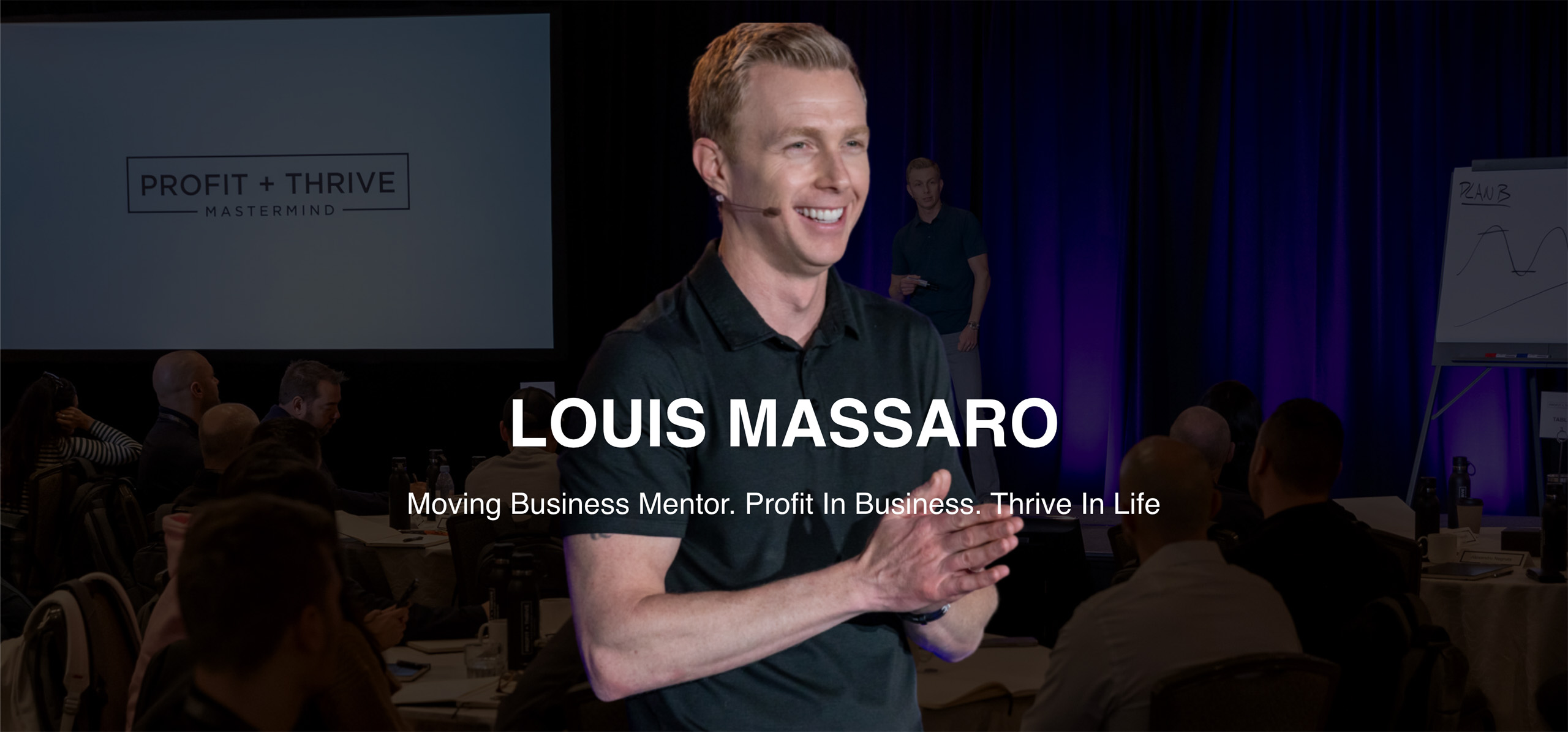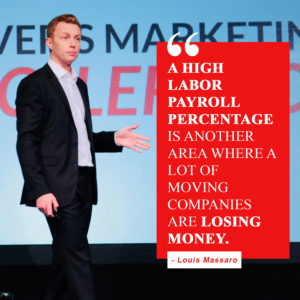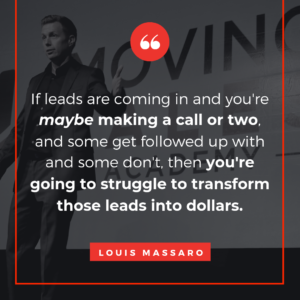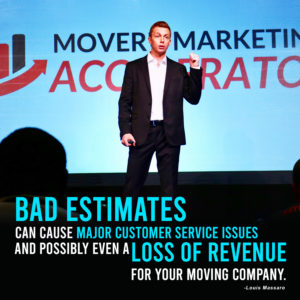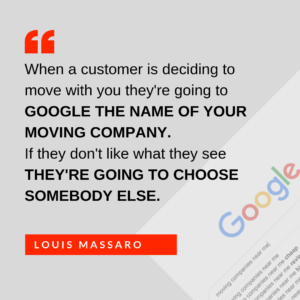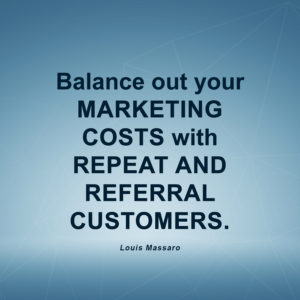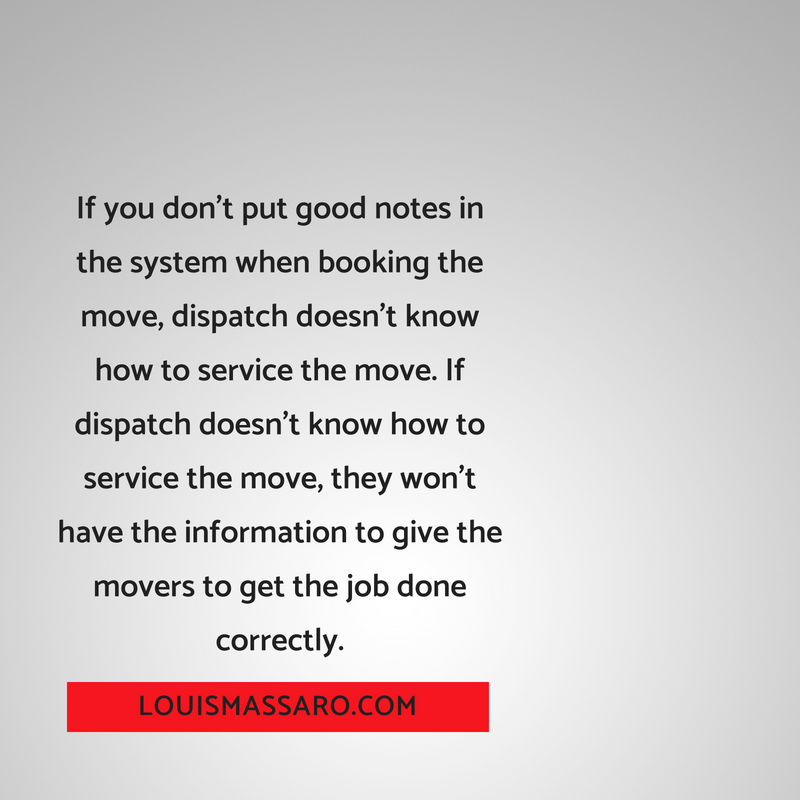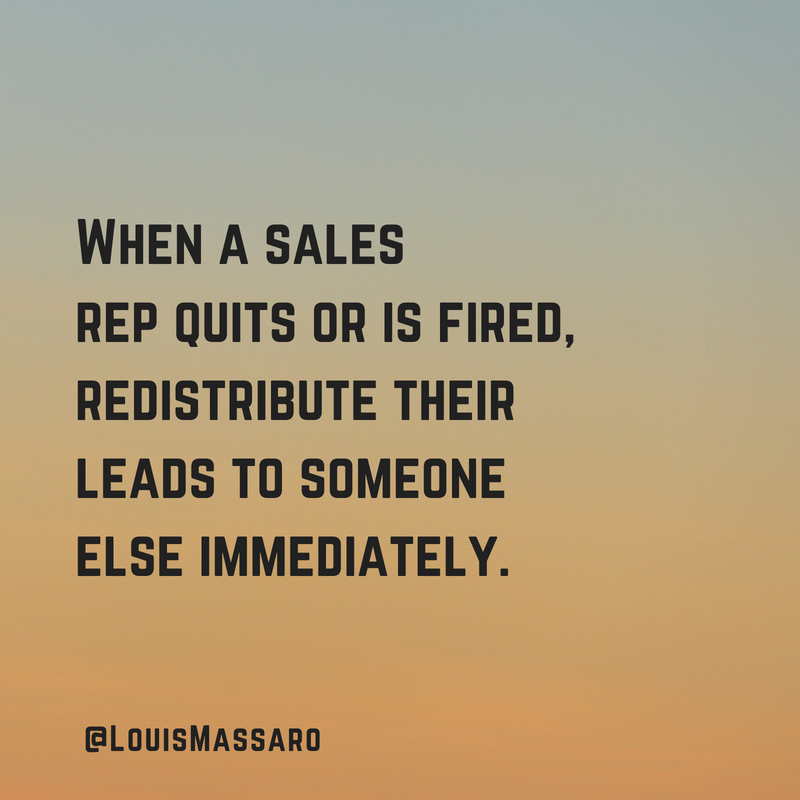► Get New Posts Via Email ► Get This Episode On iTunes
SUMMARY
In this video, Louis Massaro shares how to build a ”Moving Sales Machine” in your moving company.
- “Lead Management” Make sure that when a lead comes in (phone call lead, web lead, third-party provider lead, referral, etc.) that you’ve got your processes in place to manage them.
- “Sales Framework” This is setting up your sales scripts and establishing when you are going to go do an onsite, versus when are you going to do an estimate over the phone.
- “Sales Acceleration” For every single objection that the customer has as to why they’re not ready to move now (why your price might be too high, why they need to speak to their husband, etc.) …how to get them to book their move now.
- “Sales Control” Someone needs to wear the sales manager’s hat to ensure that the systems are running, things are smooth, nobody’s missing anything they shouldn’t miss, and the deals are consistently being closed.
- “Power Team” List out all the steps that you’re going to take when hiring, from placing an ad, to doing a phone interview, to doing an in-person interview, to checking their references to… all the stuff that you’re going to do to hire your sales team.
- “Move Multiplier” It’s taking all these moves that you booked and getting a review from this customer, getting repeat business from this customer, and getting a referral from this customer. Then upselling additional services that those customers are already in need of to increase your profit per job.
- Watch the video to get full training.
HOT NEWS & DEALS!
- Join the Moving CEO Challenge: Official Louis Massaro Community Facebook Group! A place for moving company owners to connect, share ideas, and inspire one another. Click here to join!
- Latest Instagram!
Check out @LouisMassaro for new announcements, valuable tips, and enlightening videos to take your moving company to the NEXT LEVEL!
RELATED POSTS
Misconceptions About Sales By Moving Companies
Build a Moving Company Sales Script
Best Sales & Marketing Advice for Moving Companies
Why Your Sales Team Is Not Following Up
Hire Rock-Star Moving Sales Consultants
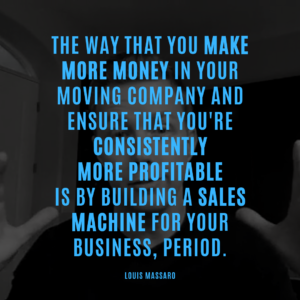
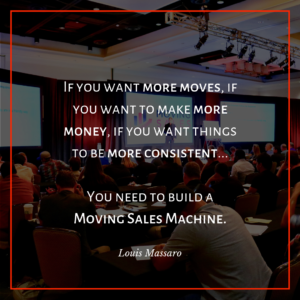
TRANSCRIPTION
Hey, my friend. It’s Louis Massaro, CEO of Moving Mastery, where we help moving company owners set up proven systems and processes to increase profits, reduce stress, and live a better quality of life. Clients will often come to me because they want to create a consistent, predictable money-making machine with their moving company, and the way that they do that is with sales. And they’re just frustrated because they don’t have the consistency of jobs being booked the way that they want. They’re doing all the marketing. They’ve got the salespeople there, but they just can’t seem to keep the trucks rolling on a consistent basis. They’re busy in the summer. They’re busy at the end of the month. They’re busy on the weekend. But then there’s just these gaps of inconsistency. So they’ve got everything they need, but it’s like, “How do I fill up the schedule? How do I make more money in my business and make sure that I’m more profitable?”
And the way that you do that is by building a sales machine for your business, period. This is the number one thing. If you want to make more money in your moving company, you need to build a sales machine. People will ask me a lot like, “Louis, how did you build a $20 million business?” And when I think about it, it’s sales. From day one, it was sell, sell, sell. That was me by myself in a truck rental yard with my Nextel walkie-talkie/flip phone and driving around booking moves, all the way to having my call center with 60 plus sales reps on the phone booking moves for all my offices. It was sales, sales, sales.
No matter what business you’re in, all businesses require strong sales in order to thrive. It’s not enough just to go out and do good moves. It’s not enough. You’ve got to have the sales, and it doesn’t have to be that hard. Alumni of our Moving Sales Academy program, I mean, I get testimonial videos on a daily basis or emails from them telling me the results that they’ve seen, and it’s all because they implemented a sales machine. They just put the steps in place one at a time and put it all together.
And it just turns your whole business around. All of the stuff that you could be struggling with, even finding quality movers. A lot of people struggle with finding quality movers. Well, it’s hard to go out and find movers if you don’t have the work for them. If you’ve ever experienced, when you do put an ad, and you do get movers in the door, but then you’re like, “Okay, well we don’t have enough moves to get them all in the rotation.” Booking the moves and then getting the help helps to really bring that all into balance.
So it’s crucial to have a sales machine in your business in this modern-day of the moving business. I mean, it’s really easier than ever with the way you can access leads, the way that you can access all the marketing, the way that you can network online and through social media, to be able to generate the opportunities. But once you get those opportunities, once you get those leads, once you get those phone calls, what happens from there? And what happens from there really is what makes the difference between the companies that are doing okay and the companies that are thriving and crushing it and making a lot of money.
So we know you need to build a sales machine. How do you go about doing that? And you do it in six steps. So the first step in order to create your sales machine for your moving business, and I don’t care what level you’re at, if you’re just starting out, you need to do this. If you’ve got 10 locations, if you’re doing $15 million a year, you need to do this. First thing you need to take care of is lead management. You need to make sure that when a lead comes in, phone call lead, web lead, third-party provider lead, referral, anything, that you’ve got your processes in place to manage that, that you get it loaded into your CRM so that you have that lead capture so that you could actually do follow-up. You can actually reach out to that customer. You could call them. You could leave a message. You can email. You can text. You can mark it for follow-up so that you follow up with them days later.
You want to make sure that you’ve got email automation through your system as well to where lead comes in, you start dropping value-building emails to that customer that’s helpful stuff for them. Not like, “I’m the greatest. Buy now. I’m the greatest. Buy now,” but value that the customer will really appreciate. You need all this stuff in order as part of your lead management process to help make things smooth and efficient. You don’t want to have poor lead management be the reason that you’re booking less moves. If you need a system that could do all that, of course, I’m co-founder in SmartMoving software. You could do it all in there, but really, you could probably do it in most CRMs, but you just want to make sure that you have a system for doing that.
The second thing that you want to focus on is what I call your sales framework. This is setting up your sales scripts. You may hear me talk about this a lot, but it’s because I really attribute it to my success and the reason that we were able to book so many moves without spending extraordinary amounts of money on marketing and be able to get that in line, to where we’re profitable. You also need to establish when are you going to go do an onsite versus when are you going to do it over the phone. Having that laid out, so nobody has to think about it. Call comes in. It’s three bedrooms. It’s 60 miles from the office. Do it over the phone. Call comes in, four bedrooms right up the street. Send somebody out there to do an onsite.
And I’m just giving examples, but you’ve got to be able to set that up so where people know, and it flows. The thing about a machine, and the reason I call it a sales machine is because a machine just flows. It doesn’t have to stop, get up, go ask somebody what to do. All this stuff is in place, and that’s really part of setting up your sales framework.
And then once you’ve got that framework set up, once you’ve got all your stuff in place, you want to move on and set up what I call sales acceleration. Sales acceleration is, okay, what do we say to the customer to get them to book now? When the customer says, “Your price is too high,” okay, does my sales team have a rebuttal for that? For every single objection that the customer has as to why they’re not ready to move now, why your price might be too high, why they need to speak to their husband, what can you say to get them to book their move now.
What’s the psychology? You’ve got to train your reps. They have to understand where your customer’s coming from. You can’t just sit them in a seat and expect them to talk to somebody without realizing that, hey, look, all of our customers, they’re coming to us. They’re kind of stressed out. They’ve got a lot going on. They’re moving. Not only are they moving their furniture, they’re moving their life. They’re probably putting their kids in new schools. They’ve got to go to a new grocery store. They’ve got to set up the cable. There’s all these things that they have to do. They have to understand the psychology of the customer, and they also have to know how to take that customer by the hand and lead them to the sale. This is a huge component of sales acceleration, how to be able to do that.
Then once you’ve got all that going, now, you need sales control. Sales control’s basically your sales management. Because the machine, it’s going to run. It’s going to produce a lot of moves, but you need to manage it. So whether you have a sales manager, or maybe you don’t have a sales manager, but someone needs to wear the sales manager’s hat to ensure that the systems are running, things are smooth, nobody’s missing anything they shouldn’t miss, and the deals are consistently being closed.
Fifth thing that you want to do is you want to set up your power team. So you’ve already established who your moving consultants are, who your sales team is, who your onsite estimators are, but now you want to bring in additional help. You’ve got to have a process to hire quickly. I can’t stress that enough. It’s not hard to hire quality moving consultants to get on the phone and book moves if you have a step-by-step process to hire and train. So just list out all the steps that you’re going to take from placing an ad to doing a phone interview to doing an in-person interview to checking their references to, all the stuff that you’re going to do to hire. And when you establish that you need somebody, that’s it. Start the steps. Place the ad. Go from there. Then once they’re hired, you have a set training program. And then you get your power team in place.
And then part of that too is establishing your commission and your pay structure to make sure that your sales team is incentivized. You’ve got to make sure they’re incentivized, not only your sales team but your sales manager. So they’ve got their commissions. They’ve got spiffs, and a spiff is something that’s just kind of like, “Hey, guys, whoever books the next five jobs, I’m going to give you 20 bucks. Hey, guys, if you book 50 jobs this week as a company, I’m going to buy lunch for everybody on Friday.” That’s a spiff. So you want to have this type of stuff structured and laid out, and again, I’m going fast here. There’s a lot but one step at a time. It’s not hard to implement all of this at all.
The sixth and final step is move multiplier. It’s taking all these moves that you booked and saying, “Hey, let’s make sure this doesn’t stop here. Let’s get a review from this customer. Let’s get repeat business from this customer. Let’s get a referral from this customer. Let’s multiply this. Not only that, let’s take the jobs that we are already booking, and let’s look for ways that we could upsell additional services that those customers are already in need of to increase our profit per job.”
So when you look at it, and you look at it as a whole, it’s like, “Okay, it’s really just a bunch of little steps, that when we put all these little steps in place, we now have a sales machine.” This is basically exactly what Moving Sales Academy consists of. Those of you who have heard of or are in my Moving Sales Academy online course, this is what it is. It walks you through this step by step how to do this. But I wanted to give you the layout of what you need to do so that you could just do it on your own. You got to set up your lead management, your sales framework, your sales acceleration, your sales control, which is your sales management, then your power team, then your move multiplier.
This stuff here, I know from my own company and going from working out of a truck rental yard to $20 million a year and I know from all the people that have gone through our online program or seminars and all the testimonials that we receive from them, it works. So you can’t look at it and say, “I’m just a moving company. I don’t want to deal with all that. I just want to do moves and do a good job.” And my answer to that is, if you have enough moves, and you’re happy with the amount of moves that you have, great. Keep doing what you’re doing. Nobody says that you have to have a sales machine in place or sales processes in place. But if you want more moves, if you want to make more money, if you want things to be consistent, these are the steps that you need to take, and you take them one at a time. That’s all. Anything that’s a big task, that’s a big project, no problem. Just break it down, step one, step two, step three, and you build it.
My advice to you is that as you start to do this, go in this exact order, okay, lead management, sales framework, sales acceleration, sales control, power team, move multiplier. If you need help with it, definitely email us and ask about Moving Sales Academy. It’ll walk you through step-by-step how to do it.
I hope this was helpful. Until I see you next time, go out there every single day, profit in your business, thrive in your life. If you found what we talked about today helpful, please share this with somebody out there on social media or with a friend that it might help them. And if you liked this video, I’d appreciate if you liked it as well. I’ll see you next time, my friend.
